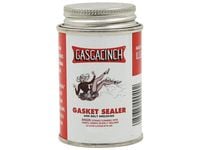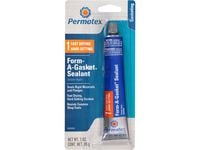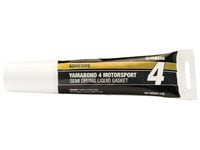One night long ago after a clandestine street race, a Cycle World staffer, who shall remain nameless, returned home, only to hear a strange squeaking noise emanating from his motorcycle engine. A subsequent teardown revealed rubbery blue chunks of silicone sealer inside the cylinder head’s oil galleys. Oh, they were pretty—rivaling a geode found in the desert—but they also did a terrific job of blocking oil flow to the camshaft lobes and rocker arms. Hence, the squeaks as dry lobes pushed against dry rockers. And that was the night during which the importance of choosing the correct sealers for the job became permanently implanted in his brain, and ours. Not every gasket surface requires sealer, of course. But if you need some, here are three good ones for motorcycle jobs.
This classic sealer works on numerous types of mating surfaces found in many motorcycle engines, such as cylinder-base gaskets or clutch-, gearbox-, and alternator-cover gaskets. The screw-top can includes an applicator brush, letting you apply just the right amount of sealer to either the gasket or the mating surfaces of the cases. Tip: Since Gasgacinch remains flexible, it’s easy to remove residue simply by rubbing. The maker says it works in hot or cold, wet or dry, acidic or basic conditions as well.
FedEx used to have a saying, “When it absolutely, positively has to be there overnight.” Well, jack up that philosophy and move it over to this sealer, and change the ending to “…has to seal up good and tight.” Permatex Form-A-Gasket #1 Sealant comes in a smallish 3-ounce tube, which makes applying it pretty simple and precise. Designed for use on rigid materials and flanges, the sealant dries fast and sets up hard, is oil- and fuel-resistant, and works in conditions from -65 to 400 degrees Fahrenheit. Just beware that removing it later can take some work.
The precision that the Japanese brought to motorcycle manufacturing in the 1950s and beyond changed the game for the better. One of the advancements was such precision machine work on crankcases that, in some examples, no center gasket was required. Instead, a special sealer, applied between the case halves before final assembly, ensured oil wouldn’t leak out, and that—especially important with two-stroke engines—air wouldn’t leak in. Yamalube Yamabond 4 is the ticket here. Just clean the crankcase surfaces, apply the sealer, bolt together, and fuhgettaboutit!



/cloudfront-us-east-1.images.arcpublishing.com/octane/AAN4TI76M5H5JMUVEIGASWXBDU.jpg)
/cloudfront-us-east-1.images.arcpublishing.com/octane/P3RXD2UCPFF37CMB7CHPVKXORY.jpg)
/cloudfront-us-east-1.images.arcpublishing.com/octane/VZEG2EJI2RDFZNHLRZMU56MD3Q.jpg)
/cloudfront-us-east-1.images.arcpublishing.com/octane/GVJQO5FFOFBWNGODOBRB4FBAW4.jpg)
/cloudfront-us-east-1.images.arcpublishing.com/octane/BIVAK2SFIBDJJM25E7I5VU2FJE.jpg)
/cloudfront-us-east-1.images.arcpublishing.com/octane/CH5VX52UG5CFHOVH5A6UYEFWWA.jpg)
/cloudfront-us-east-1.images.arcpublishing.com/octane/ZVGJNGZRU5C33N7KN23BBFKSC4.jpg)


/cloudfront-us-east-1.images.arcpublishing.com/octane/CZ5OM3E43ZEXJHY7LCYXCHLIKI.jpg)
/cloudfront-us-east-1.images.arcpublishing.com/octane/DF5T4K5KPZFJXFCTGPYR77PKJM.jpg)
/cloudfront-us-east-1.images.arcpublishing.com/octane/RMCT2KVQBJHBZMRTSLOVPMOILU.jpg)

/cloudfront-us-east-1.images.arcpublishing.com/octane/K45KB2XHQVA65DX7VN4ZSMT2BI.jpg)
/cloudfront-us-east-1.images.arcpublishing.com/octane/FNHXQQ56BRD7TO4YIJ453PNG2M.jpg)
/cloudfront-us-east-1.images.arcpublishing.com/octane/OIKJC4JA3ZH7BMKUGWYKBIY5FA.jpg)
/cloudfront-us-east-1.images.arcpublishing.com/octane/MT2SAEWY6FDXFBYSLDE3AEFDTM.jpg)
/cloudfront-us-east-1.images.arcpublishing.com/octane/66UPKPYVURBPRCP5HXSN56MEMM.jpg)
/cloudfront-us-east-1.images.arcpublishing.com/octane/EOREGDSRKFDCRJC6K3EDVHBGCE.jpg)
/cloudfront-us-east-1.images.arcpublishing.com/octane/42RF63Q3LVCMBP3DGTWXFYSMOA.jpg)
/cloudfront-us-east-1.images.arcpublishing.com/octane/XNVY3EVWZFCEVPUGJGAN633LXE.jpg)
/cloudfront-us-east-1.images.arcpublishing.com/octane/2PLTVHXY7FDSPFHKU5CFOC43ZY.jpg)
/cloudfront-us-east-1.images.arcpublishing.com/octane/B6M3WTRLFZGNXBEATNXPVGBBD4.jpg)
/cloudfront-us-east-1.images.arcpublishing.com/octane/4CMH3FI73BEM5D6MFYX42FLDSQ.jpg)